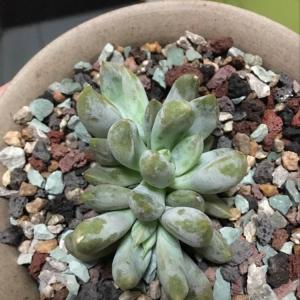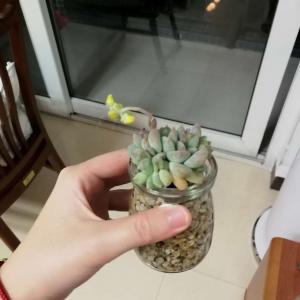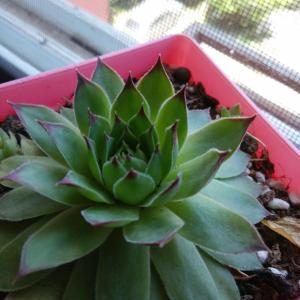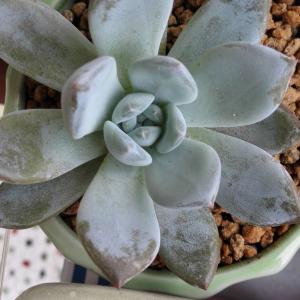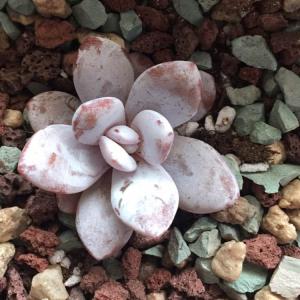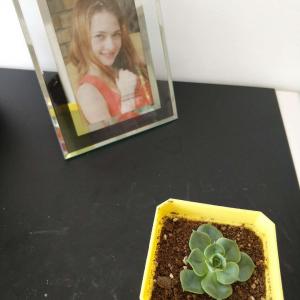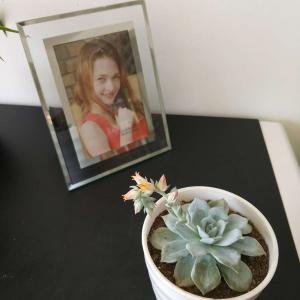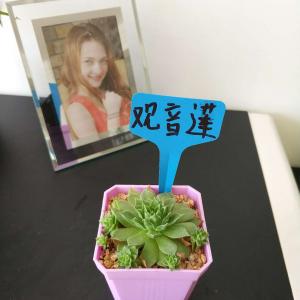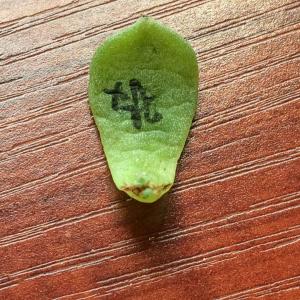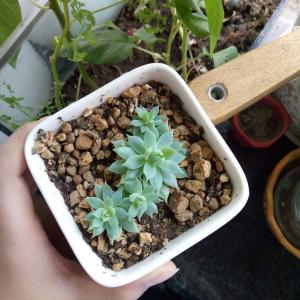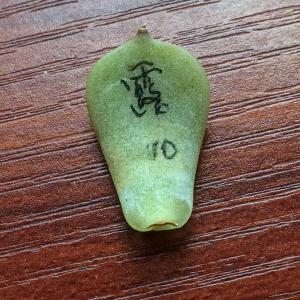文章
权问薇
2017年07月20日


“自李唐来,世人皆爱牡丹,予独爱莲···”
当周敦颐写下这篇爱莲说时
他一定想不到
几百年后在另一片土地上
有一个人,和他一样对荷花爱的深沉

拍照只是他的业余爱好
但就是这样一名爱好者
花费了他41年的时间
拍摄了无数让人沉醉的荷花

他镜头下的荷花
每一张都像一幅水粉画
柔得似锦,静得如水
让人如临仙境
下面就和花花一起静静的欣赏吧













0
0
文章
贾宗伟
2017年07月20日

在拟石莲花属中根据其叶片,颜色特性再细分五类,想想也挺有趣的,下文作者是台湾花友alo(阿肉)在韩国网站上看到关于拟石莲花属的分法后整理分享给大家参考,事实上更科学的划分法有17类,可参考文末,英语好的同学可以帮忙翻译翻译。文中的品种名字叫法虽然有些不一样,但猜猜基本还是能猜对,大家可以比较比较。
看到某个韩国网站介绍多肉,对拟石莲花属(Echeveria)用叶形状、颜色分成5个种类。
在这边分享给各位,当然许多品种实在是你说他属A类也可以、B类也可以...
此区分法并非绝对,但提供了明确的分类大项,很有趣的观点。
园艺是门专业的学问,能够更多人讨论、收敛、归纳。
因而找出更好精细科学的方法,这亦是玩花种花之外的另一个乐趣。
欢迎大家能够一起讨论,这才好玩嘛!
1.单一叶(Accents)
单一叶是指叶形状单一、基底色单纯(不考虑因低温缺水变色状况)
像东云系、卡罗拉等归类在这一类中,看例的举子是指叶形像下图的:
亦即叶形由茎向叶尖是慢慢缩小,不会再出现其它变化。
以这个基础来说,东云没有什麽大问题,基本上桃太郎、吉娃娃、卡罗拉也是。此外像霜之朝、蓝鸟、墨西哥巨人也归属在这类中
白凤、吉娃娃
东云平安夜、蓝鸟
照这个分类基础来说,黑王子、凯特、蓝金属等也算是单一叶类吧~
呃……看起来似乎不是,所以接着我们来看看第二类吧~
2.彩色叶(Colours)
在上述单一叶形的基础上,如果叶片颜色有变化,就会归类在彩色叶。
颜色可呈现2种(含)以上,就属於这类。
但这问题就来了,像吉娃娃的叶背是红色,但基底是绿色,不也两种?
这就需要将定义再说的明显一点,个人认为啦。
叶片中的多种颜色是可以出现在叶片所有地方,而不是特定点,且颜色变化明显。
举个例,最常见的市场肉黑王子和大银明色。
黑王子和大银明色一样,如果没晒太阳就会变成"绿王子"和"大绿明色"XD
在正常露养环境下,黑王子的黑色会有很多种变化,甚至也会同时保留绿色成份
黑王子、大银明色
当然最好分的就像是饰莲、七变化、彩度、晚霞这些同时有明显多种颜色的
不过在这里我就有些疑问了,像织锦、莱姆辣椒这类天生有黄色锦线条的。
也算在彩色叶这类?还是要忽略锦条算在单一叶呢?
饰莲、紫啸鸫
莱姆辣椒、织锦
3.几何叶(Geometrics)
几何泛指叶片形状多变,不像单一叶的形状简单
在这分类中似乎不考虑颜色,只要叶形有变化都归在此类中
简单来说,只要叶片末端忽然胖起来的都算
常见有特叶玉蝶、老乐、萝拉、桃之娇等
不知像大瑞蝶这种叶片会内凹的算不算在此类?
特叶玉蝶、红日伞
桃之娇、萝拉
4.卷褶叶(Frills)
此类就是大家俗称的高丽叶品种,大多是以沙薇娜为主的园艺种或杂交种。
而这类很多都是由美国加州知名的园艺大师Dick Wright所杂交出来。
特点就是叶片末端呈现蕾丝卷褶状,通常叶片都较薄。
很多卷褶叶的拟石莲都是中大型种,养起来特有成就感呢~
有趣的是,这类有些品种也包含彩色叶的特性,像昂贵的飞翔云XDDD
晚霞之舞、米娜斯
Zorro(黑罗勒?)、晨光
5.瘤状叶(Bumps)
只要叶片上有瘤的,都算此分类
同样的,很多也出自於Dick Wright之手
至於瘤,在幼年期时是不会有的,通常都要成长到一个阶段後才会浮现
这也是为何常有人把女王花笠和高砂之翁的小苗给搞混了
瘤发生的机制还不明,有一学说是病毒感染的关系
当然瘤出现的功能也不明,莫非是让动物觉得恶心不想去碰?XDDDDDD
总之瘤状的拟石莲,审美观真的是各人各有不同见解
像雨滴、女王花笠的瘤就蛮多人喜爱的
但乙女之梦、狂野男爵,似乎就没有那麽多人欣赏
狂野男爵、女王花笠狂
李锡坚老师补充的资料,Walther将拟石莲属分为14类
之後Myron Kimnach於2003加以补充,将143个品种分为17类
於ICN上可看到James E.Low发表的文章简短地概述了这17类的分类(英语好的同学可以帮忙翻译翻译):
1.Angulatae,[Roots often tuberous;stem nearly lacking;small,narrow leaves;the inflorescences with one to several cincinni;petals acutely keeled and thick].Now with 10 species.
2.Chloranthae,[Stems nearly lacking;infl.with 1 cincinnus;petals short and stout,green in color and obtusely keeled].Only 1 species.
3.Ciliatae,[Stems short to medium;leaves pubescent(hairy)to glabrous(no hairs);infl.racemose or paniculate and often hairy].Now with 8 species or ssp.
4.Echeveria,[Stems medium to tall;minutely puberulent to hirstute(fine to medium hairs);infl.a spike or equilateral raceme;often pubescent].Now with 9 species or ssp.
5.Gibbiflorae,[Stems short to medium;glaberous(no hairs);infl.a paniculate cyme(a“thyrse”)with branches being a cincinni,rarely pubescent].Now with 22 species or ssp.
6.Longistylae,[Stems nearly lacking;leaves glabrous(without hairs);infl.with 1 or 2 cincinni;corolla to 3 cm.long;styles 2 cm.long].Now with only 1 species.
7.Mucronatae,[Roots tuberous;stems nearly lacking;leaves glabrous&small;infl.spicate or sub-racemose;petals to 2 mm long].Now with 3 species.
8.Nudae,[Stems tall;leaves glabrous or papillose(hairless to fuzzy);infl.a raceme,rarely a spike].Now with 25 species or ssp.
9.Occidentales,[Roots not tuberous;stems nearly lacking;leaves small to medium;infl.a cyme,much-branched apically,with cincinni;corollas red].Now with 2 species.
10.Paniculatae,[Roots not tuberous;stems short;leaves small&glabrous;infl.cymose-paniuculate,with cincinni;corollas very small].Now with 3 species.
11.Pruinosae,[Stems short;leaves small to medium and pruinose(white-frosted)to glaucous;infl.with 1 to 3 cincinni;petals thick].Now with 3 species.
12.Racemosae,[Roots tuberous or fibrous;stems nearly lacking;rarely tall;leaves usually glabrous,rarely pubescent;infl.a raceme].Now with 33 species or ssp.
13.Secundae.[Roots not tuberous;stems nearly lacking or short;leaves glabrous,small,usually glaucous;infl.with 1 or 2 cincinni;petals obtusely keeled].Now with 6 species or ssp.
14.Spicatae,[Stems tall;leaves narrow&glabrous;infl.densely spicate or racemose;sepals often longer than the corolla;petals obtuse and keeled].Now with 2 species.
15.Thyrsiflorae,[Roots tuberous,stems nearly lacking;leaves glabrous;infl.thyrsoid or sub-racemose and determinate].Now with 3 species and ssp.
16.Urbiniae,[Roots not tuberous;stems nearly lacking;leaves small,glabrous,and often glaucous;infl.second-racemose;corollas urceolate(urn-shaped)].Now with 19 species or ssp.
17.Valvatae,[Roots not tuberous;stems nearly lacking;leaves thin and acute margined;infl.with 1 or 2 cincinni,bract leaves imbricate;sepals about as long as corollas,petals valvate:not overlapping].Now with 2 species.
看到某个韩国网站介绍多肉,对拟石莲花属(Echeveria)用叶形状、颜色分成5个种类。
在这边分享给各位,当然许多品种实在是你说他属A类也可以、B类也可以...
此区分法并非绝对,但提供了明确的分类大项,很有趣的观点。
园艺是门专业的学问,能够更多人讨论、收敛、归纳。
因而找出更好精细科学的方法,这亦是玩花种花之外的另一个乐趣。
欢迎大家能够一起讨论,这才好玩嘛!
1.单一叶(Accents)
单一叶是指叶形状单一、基底色单纯(不考虑因低温缺水变色状况)
像东云系、卡罗拉等归类在这一类中,看例的举子是指叶形像下图的:
亦即叶形由茎向叶尖是慢慢缩小,不会再出现其它变化。
以这个基础来说,东云没有什麽大问题,基本上桃太郎、吉娃娃、卡罗拉也是。此外像霜之朝、蓝鸟、墨西哥巨人也归属在这类中
白凤、吉娃娃
东云平安夜、蓝鸟
照这个分类基础来说,黑王子、凯特、蓝金属等也算是单一叶类吧~
呃……看起来似乎不是,所以接着我们来看看第二类吧~
2.彩色叶(Colours)
在上述单一叶形的基础上,如果叶片颜色有变化,就会归类在彩色叶。
颜色可呈现2种(含)以上,就属於这类。
但这问题就来了,像吉娃娃的叶背是红色,但基底是绿色,不也两种?
这就需要将定义再说的明显一点,个人认为啦。
叶片中的多种颜色是可以出现在叶片所有地方,而不是特定点,且颜色变化明显。
举个例,最常见的市场肉黑王子和大银明色。
黑王子和大银明色一样,如果没晒太阳就会变成"绿王子"和"大绿明色"XD
在正常露养环境下,黑王子的黑色会有很多种变化,甚至也会同时保留绿色成份
黑王子、大银明色
当然最好分的就像是饰莲、七变化、彩度、晚霞这些同时有明显多种颜色的
不过在这里我就有些疑问了,像织锦、莱姆辣椒这类天生有黄色锦线条的。
也算在彩色叶这类?还是要忽略锦条算在单一叶呢?
饰莲、紫啸鸫
莱姆辣椒、织锦
3.几何叶(Geometrics)
几何泛指叶片形状多变,不像单一叶的形状简单
在这分类中似乎不考虑颜色,只要叶形有变化都归在此类中
简单来说,只要叶片末端忽然胖起来的都算
常见有特叶玉蝶、老乐、萝拉、桃之娇等
不知像大瑞蝶这种叶片会内凹的算不算在此类?
特叶玉蝶、红日伞
桃之娇、萝拉
4.卷褶叶(Frills)
此类就是大家俗称的高丽叶品种,大多是以沙薇娜为主的园艺种或杂交种。
而这类很多都是由美国加州知名的园艺大师Dick Wright所杂交出来。
特点就是叶片末端呈现蕾丝卷褶状,通常叶片都较薄。
很多卷褶叶的拟石莲都是中大型种,养起来特有成就感呢~
有趣的是,这类有些品种也包含彩色叶的特性,像昂贵的飞翔云XDDD
晚霞之舞、米娜斯
Zorro(黑罗勒?)、晨光
5.瘤状叶(Bumps)
只要叶片上有瘤的,都算此分类
同样的,很多也出自於Dick Wright之手
至於瘤,在幼年期时是不会有的,通常都要成长到一个阶段後才会浮现
这也是为何常有人把女王花笠和高砂之翁的小苗给搞混了
瘤发生的机制还不明,有一学说是病毒感染的关系
当然瘤出现的功能也不明,莫非是让动物觉得恶心不想去碰?XDDDDDD
总之瘤状的拟石莲,审美观真的是各人各有不同见解
像雨滴、女王花笠的瘤就蛮多人喜爱的
但乙女之梦、狂野男爵,似乎就没有那麽多人欣赏
狂野男爵、女王花笠狂
李锡坚老师补充的资料,Walther将拟石莲属分为14类
之後Myron Kimnach於2003加以补充,将143个品种分为17类
於ICN上可看到James E.Low发表的文章简短地概述了这17类的分类(英语好的同学可以帮忙翻译翻译):
1.Angulatae,[Roots often tuberous;stem nearly lacking;small,narrow leaves;the inflorescences with one to several cincinni;petals acutely keeled and thick].Now with 10 species.
2.Chloranthae,[Stems nearly lacking;infl.with 1 cincinnus;petals short and stout,green in color and obtusely keeled].Only 1 species.
3.Ciliatae,[Stems short to medium;leaves pubescent(hairy)to glabrous(no hairs);infl.racemose or paniculate and often hairy].Now with 8 species or ssp.
4.Echeveria,[Stems medium to tall;minutely puberulent to hirstute(fine to medium hairs);infl.a spike or equilateral raceme;often pubescent].Now with 9 species or ssp.
5.Gibbiflorae,[Stems short to medium;glaberous(no hairs);infl.a paniculate cyme(a“thyrse”)with branches being a cincinni,rarely pubescent].Now with 22 species or ssp.
6.Longistylae,[Stems nearly lacking;leaves glabrous(without hairs);infl.with 1 or 2 cincinni;corolla to 3 cm.long;styles 2 cm.long].Now with only 1 species.
7.Mucronatae,[Roots tuberous;stems nearly lacking;leaves glabrous&small;infl.spicate or sub-racemose;petals to 2 mm long].Now with 3 species.
8.Nudae,[Stems tall;leaves glabrous or papillose(hairless to fuzzy);infl.a raceme,rarely a spike].Now with 25 species or ssp.
9.Occidentales,[Roots not tuberous;stems nearly lacking;leaves small to medium;infl.a cyme,much-branched apically,with cincinni;corollas red].Now with 2 species.
10.Paniculatae,[Roots not tuberous;stems short;leaves small&glabrous;infl.cymose-paniuculate,with cincinni;corollas very small].Now with 3 species.
11.Pruinosae,[Stems short;leaves small to medium and pruinose(white-frosted)to glaucous;infl.with 1 to 3 cincinni;petals thick].Now with 3 species.
12.Racemosae,[Roots tuberous or fibrous;stems nearly lacking;rarely tall;leaves usually glabrous,rarely pubescent;infl.a raceme].Now with 33 species or ssp.
13.Secundae.[Roots not tuberous;stems nearly lacking or short;leaves glabrous,small,usually glaucous;infl.with 1 or 2 cincinni;petals obtusely keeled].Now with 6 species or ssp.
14.Spicatae,[Stems tall;leaves narrow&glabrous;infl.densely spicate or racemose;sepals often longer than the corolla;petals obtuse and keeled].Now with 2 species.
15.Thyrsiflorae,[Roots tuberous,stems nearly lacking;leaves glabrous;infl.thyrsoid or sub-racemose and determinate].Now with 3 species and ssp.
16.Urbiniae,[Roots not tuberous;stems nearly lacking;leaves small,glabrous,and often glaucous;infl.second-racemose;corollas urceolate(urn-shaped)].Now with 19 species or ssp.
17.Valvatae,[Roots not tuberous;stems nearly lacking;leaves thin and acute margined;infl.with 1 or 2 cincinni,bract leaves imbricate;sepals about as long as corollas,petals valvate:not overlapping].Now with 2 species.
0
1



